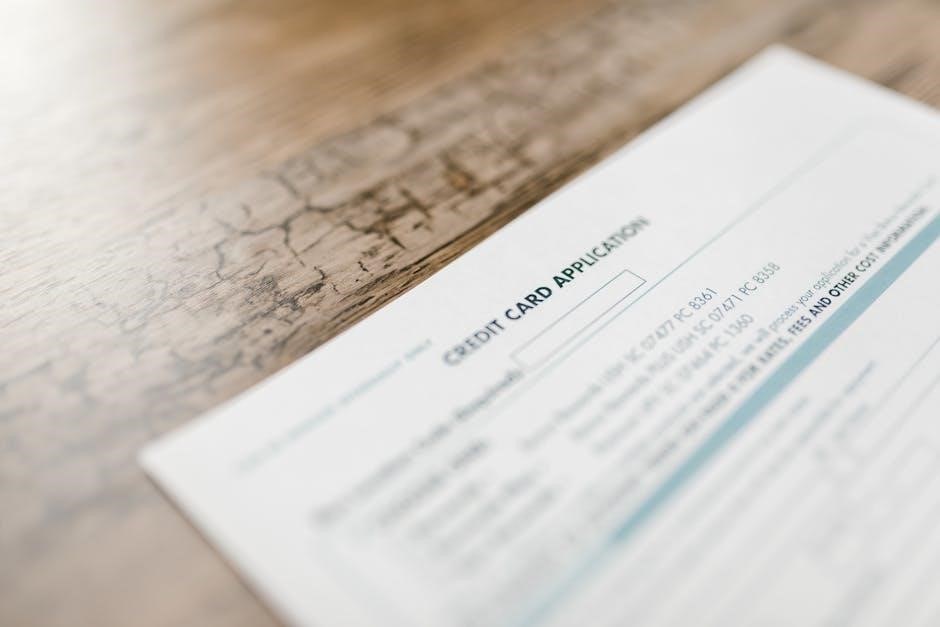The Rental Application Form 410 in Ontario is a standardized document used by landlords to assess potential tenants. It collects personal information, employment details, financial status, rental history, and references, ensuring a fair and consistent evaluation process for both parties.
1.1 Purpose of the Form
The purpose of the Rental Application Form 410 is to provide landlords with a comprehensive evaluation of potential tenants. It ensures consistency and fairness by collecting essential information about income, employment, credit history, and rental background. This standardized approach helps landlords make informed decisions while protecting tenants by establishing clear expectations for the rental process.
1.2 Importance for Tenants and Landlords
The Rental Application Form 410 is crucial for both tenants and landlords as it ensures a fair and transparent rental process. For tenants, it provides a standardized way to present their qualifications, while for landlords, it offers a structured method to assess potential tenants’ credibility and suitability. This mutual benefit fosters trust and compliance with Ontario’s tenancy laws.
Overview of the Rental Application Form 410
The Rental Application Form 410 is a standardized document in Ontario, designed to streamline the tenant screening process. It outlines essential information sections, ensuring clarity and organization for both landlords and applicants.
2.1 Structure and Key Components
The Rental Application Form 410 is divided into clear sections, including personal information, employment details, financial data, rental history, references, and additional remarks. Each section is designed to gather specific information, ensuring a comprehensive overview of the applicant’s background and suitability. The structured format facilitates easy review for landlords while maintaining clarity for applicants.
2.2 Legal Requirements and Compliance
The Rental Application Form 410 must comply with Ontario’s Residential Tenancies Act, ensuring it does not request prohibited information such as age or marital status. Landlords are legally required to handle personal data securely and avoid discriminatory practices. The form includes a declaration confirming the accuracy of provided information, reinforcing its validity under Ontario rental laws.

Eligibility Criteria for Tenants
Tenants must meet specific criteria, including stable income, positive rental history, and acceptable creditworthiness, to qualify for rental opportunities in Ontario. The form ensures a fair assessment process.
3.1 Income and Employment Requirements
Landlords use Form 410 to verify tenants’ financial stability. Applicants must provide proof of employment, such as a letter or recent payslip. A minimum gross income of three times the rent is typically required. Acceptable income sources include employment, pensions, or self-employment, though specific requirements may vary by landlord or property.
3.2 Credit Score and Financial History
A credit score of 600-900 is generally preferred for rental applications in Ontario. Landlords review credit reports for payment history, debt levels, and bankruptcies. A poor score may lead to rejection or require a co-signer. Applicants with low credit can sometimes compensate with proof of stable income or significant savings to demonstrate financial responsibility.
3.4 Rental History and References
Landlords evaluate rental history to assess reliability and responsibility. Applicants must provide references from previous landlords or property managers, detailing tenancy duration, payment history, and property condition. Negative references or unresolved disputes may lead to application rejection. A consistent, positive rental history strengthens an application, while gaps or insufficient history may require additional documentation or a co-signer.

Required Documents for Submission
Applicants must submit identification, proof of residency, financial statements, employment letters, previous tenancy agreements, and references. These documents verify identity, financial stability, and rental history for landlords.
4.1 Identification and Proof of Residency
Applicants must provide valid government-issued ID, such as a driver’s license or passport, and proof of residency, like utility bills or bank statements, to verify identity and address.
4.2 Financial Statements and Employment Letters
Applicants must submit recent pay stubs, bank statements, or a letter from their employer confirming salary and employment duration. These documents verify income stability and employment status, crucial for assessing rental eligibility and financial reliability. Additional proof, such as a T4 slip or Notice of Assessment, may also be requested to validate income claims.
4.3 Previous Tenancy Agreements and References
Applicants must provide previous tenancy agreements and references to demonstrate rental history. These documents include lease terms, payment records, and landlord contacts. They help landlords assess reliability and past behavior, ensuring a tenant’s credibility and suitability for the property in the evaluation process.

Filling Out the Rental Application Form 410
Filling out Form 410 requires careful attention to detail to ensure accuracy and completeness. This step-by-step process helps landlords evaluate potential tenants fairly and efficiently.
5.1 Personal Information Section
The Personal Information Section requires applicants to provide their full name, date of birth, contact details, and identification documents. This ensures landlords can verify identity and maintain communication throughout the process.
5.2 Employment and Financial Details
This section requires applicants to provide employment information, including their job title, employer, length of employment, and income details. Financial details such as bank statements, savings, and debt obligations are also requested to assess the applicant’s financial stability and ability to meet rental payments consistently.
5.3 Rental History and References Section
This section asks for details about previous landlords, rental amounts, and tenancy dates. Applicants must also provide references, which may include past landlords or property managers. This helps landlords assess the applicant’s reliability and rental history, ensuring a more informed decision-making process for both parties involved in the tenancy agreement.
5.4 Additional Information and Declarations
This section allows applicants to provide any additional information that may support their application, such as special requests or unique circumstances. Declarations confirm the accuracy of the submitted information, compliance with rental regulations, and consent to necessary background checks. Applicants must sign and date the form, acknowledging all terms. This ensures a clear understanding between both parties involved.
Submitting the Completed Application
Once completed, the application can be submitted in person or electronically, depending on the landlord’s preference. Ensure all required documents are included to avoid delays. Landlords may request additional information post-submission.
6.1 In-Person Submission
Submitting the application in person allows direct interaction with the landlord or property manager. Ensure all required documents are neatly organized and completed. This method provides immediate confirmation of receipt and an opportunity to address any questions or clarifications on the spot, enhancing transparency and efficiency in the process.
6.2 Electronic Submission
Submitting the application electronically offers convenience and flexibility, allowing applicants to upload required documents from any location with internet access. This method often provides a swift delivery and confirmation of receipt, ensuring peace of mind. Electronic submissions may also enhance security through encrypted portals and allow for immediate follow-up communications, making the process efficient and reliable.

Processing and Evaluation of the Application
The processing phase involves a thorough review of the submitted application, focusing on the applicant’s financial stability, rental history, and compliance with eligibility criteria to determine suitability.
7.1 Timeline for Processing
The processing of Form 410 typically takes 3-7 business days, depending on the landlord’s workload and the complexity of the application. Delays may occur if additional verifications are required, such as employment checks or reference confirmations. Tenants should follow up politely if the timeline exceeds expectations, ensuring all documents are submitted correctly to avoid unnecessary delays.
7.2 Criteria for Approval or Rejection
Landlords evaluate Form 410 based on income stability, creditworthiness, rental history, and references. Approval typically requires income exceeding 3x the rent, a decent credit score, positive references, and no history of eviction. Rejection may occur due to insufficient income, poor credit, negative rental history, or incomplete applications. Landlords must comply with fair housing laws to avoid discrimination.

Fees Associated with the Application
Fees associated with the Rental Application Form 410 in Ontario typically include a non-refundable application fee, often up to $40, as per provincial regulations.
8.1 Application Fees and Deposits
The application fee for Form 410 typically covers processing and screening costs, often capped at $40 by Ontario regulations. This non-refundable fee helps landlords assess suitability. Additionally, a refundable security deposit may be required upon approval, separate from the application fee, to secure the tenancy and cover potential damages.
8.2 Refund Policies
Refund policies for the Rental Application Form 410 vary by landlord. If the application is rejected, the fee may be partially or fully refundable, depending on provincial regulations; Security deposits are typically refundable after the tenancy ends, minus any deductions for damages or unpaid rent. Applicants should review the refund policy before submitting payments.

Understanding the Tenancy Agreement
The tenancy agreement is a legal contract outlining the terms and conditions of the rental relationship. It includes lease duration, responsibilities, and rent details, ensuring clarity and protection for both tenants and landlords. Understanding it is crucial for a harmonious and legally compliant tenancy.
9.1 Key Terms and Conditions
The tenancy agreement outlines essential terms such as lease duration, rent amount, payment terms, and tenant/landlord responsibilities. It also includes rules for property use, maintenance, and modifications. These legally binding conditions ensure both parties understand their obligations and rights, providing a clear framework for the rental relationship and compliance with Ontario’s tenancy laws.

9.2 Rights and Responsibilities
Tenants have the right to a habitable property, privacy, and timely repairs, while being responsible for rent payment, maintaining the unit, and adhering to lease terms. Landlords must ensure the property is safe, address repairs promptly, and provide notice for entry or lease changes. Both parties must fulfill their legal obligations to maintain a fair rental relationship under Ontario’s Residential Tenancies Act.
Common Mistakes to Avoid
Common mistakes include omitting required information, providing inaccurate details, or failing to submit necessary documents. These errors can delay processing or lead to rejection of the application.
10.1 Incomplete or Inaccurate Information
Submitting an application with incomplete or inaccurate information is a common mistake that can delay processing or lead to rejection. Ensure all sections are filled out thoroughly and truthfully, as false or missing details, such as employment history or rental references, can raise concerns and jeopardize your chances of approval.
10.2 Missed Deadlines
Missing deadlines for submitting the Rental Application Form 410 can result in lost opportunities to secure a rental property. Landlords often prioritize timely applications, so delays may lead to the property being rented to another applicant. Ensure you submit your application well before the specified deadline to avoid disappointment and maintain a competitive position.

What to Expect After Submission
After submitting the Rental Application Form 410 in Ontario, applicants can expect a review period, potential follow-up for additional information, and a final decision regarding tenancy approval.
11.1 Communication from the Landlord
After submitting Form 410, landlords typically review the application and may contact applicants for additional information or clarification. Communication methods include email, phone calls, or in-person meetings. Landlords will notify applicants of their decision, whether approved, rejected, or requiring further review. Clear and professional communication ensures both parties are informed throughout the process.
11.2 Next Steps if Approved
If approved, the landlord will typically request a signed tenancy agreement and a security deposit. Applicants should review the lease carefully, ask questions, and ensure all terms are understood. Once agreed, the tenant will receive keys and access to the property on the agreed move-in date, completing the rental process.

Dispute Resolution and Legal Considerations
Understanding legal rights and dispute resolution is crucial. Tenants and landlords can resolve issues through mediation or tribunals, ensuring fair treatment under Ontario’s rental laws and regulations.
12.1 Handling Rejection or Disputes
If an application is rejected, tenants should seek clarification on the reasons. Disputes can be addressed through Ontario’s Landlord and Tenant Board, ensuring fair treatment and resolving conflicts legally.
12.2 Legal Recourse for Tenants
Tenants facing unfair rejection or disputes can seek legal recourse through Ontario’s Landlord and Tenant Board. If discrimination or improper screening occurs, tenants may file complaints under the Human Rights Code. Legal advice from tenant rights organizations or lawyers can help navigate these processes effectively.
The Rental Application Form 410 is crucial for securing Ontario rentals. Ensure accuracy, honesty, and completeness to increase approval chances and maintain a positive landlord-tenant relationship.
13.1 Summary of Key Points
The Rental Application Form 410 in Ontario is a standardized document designed to streamline the tenant screening process. It collects essential information about potential tenants, including personal details, employment history, financial stability, and rental background. By providing accurate and complete information, applicants can demonstrate their reliability and increase their chances of a successful application. Understanding and adhering to the form’s requirements ensures a smooth process for both landlords and tenants.
13.2 Best Practices for a Successful Application
To ensure a successful rental application, start early and gather all required documents in advance. Provide accurate and truthful information to avoid rejection. Highlight your strengths, such as stable employment and positive references. Follow submission guidelines carefully and consider including a cover letter. Double-check for errors before submitting, and maintain open communication with the landlord throughout the process.
